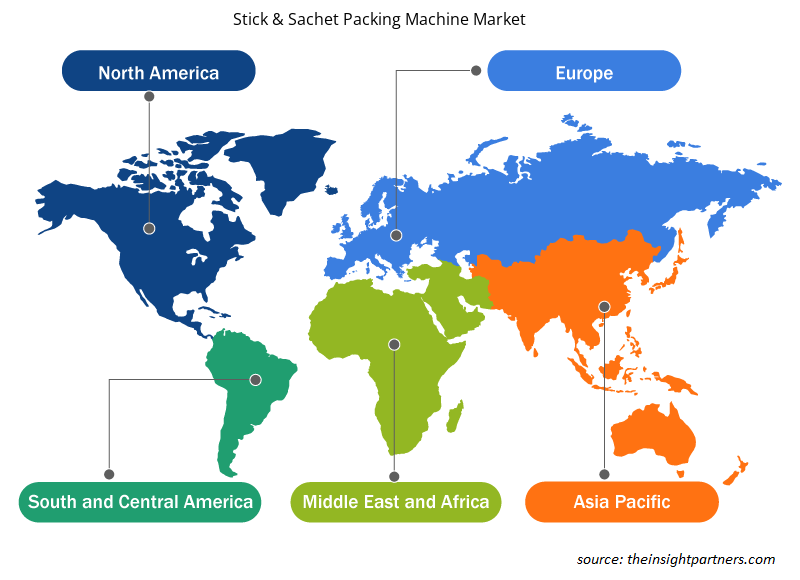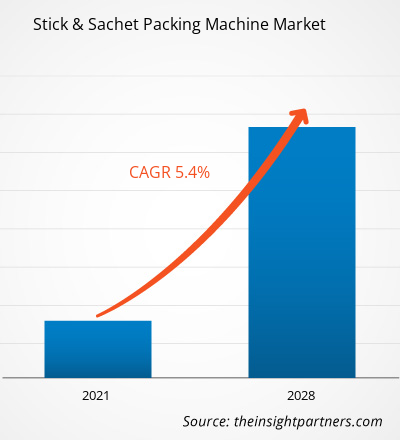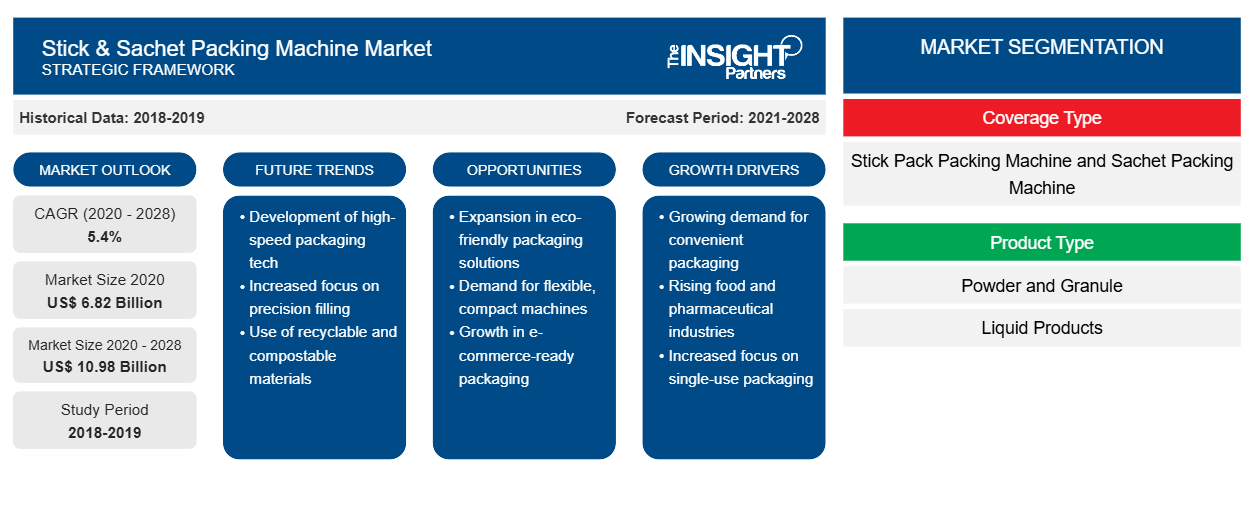Le marché des machines d'emballage de bâtons et de sachets a été évalué à 6 819,38 millions USD en 2020 et devrait atteindre 10 978,92 millions USD d'ici 2028. Il devrait enregistrer un TCAC de 5,4 % au cours de la période de prévision.CAGR of 5.4% during the forecast period.
L'industrialisation rapide à l'échelle mondiale, les préférences croissantes des consommateurs pour les produits emballés, la croissance de l'industrie agroalimentaire, l'accent croissant mis sur la fourniture de services de maintenance intelligents et l'optimisation élevée des processus d'emballage sont quelques-uns des facteurs susceptibles de stimuler la croissance de ce marché au cours de la période de prévision. Dans la projection mentionnée ci-dessus, l'évolution de l'industrie du commerce électronique et la prévalence de canaux de distribution améliorés offrent de nombreuses opportunités pour la croissance du marché mondial des machines d'emballage de bâtonnets et de sachets.
Les principaux acteurs de l'écosystème du marché mondial des machines d'emballage de bâtons et de sachets sont les fournisseurs de matières premières, les fabricants de machines d'emballage de bâtons et de sachets et les utilisateurs finaux. Les fournisseurs de matières premières sont les premiers acteurs du marché car ils fournissent divers métaux, tels que l'acier, l'acier doux, les plastiques, le plastique renforcé de fibres de verre (GRP) et les métaux ferreux. Ces matériaux améliorent la qualité des composants pour de meilleures performances et une meilleure durée de vie.GRP), and ferrous metals. These materials improve the components' quality for better performance and lifespan.
Personnalisez ce rapport en fonction de vos besoins
Vous bénéficierez d'une personnalisation gratuite de n'importe quel rapport, y compris de certaines parties de ce rapport, d'une analyse au niveau des pays, d'un pack de données Excel, ainsi que de superbes offres et réductions pour les start-ups et les universités.
- Obtenez les principales tendances clés du marché de ce rapport.Cet échantillon GRATUIT comprendra une analyse de données, allant des tendances du marché aux estimations et prévisions.
Impact de la pandémie de COVID-19 sur le marché des machines d'emballage de bâtonnets et de sachets
L'épidémie de COVID-19 a eu un impact négatif sur les entreprises manufacturières du monde entier, mais le marché mondial des machines d'emballage de bâtonnets et de sachets a été relativement peu affecté. La majorité des entreprises d'emballage sont pleinement opérationnelles avec une capacité accrue, tandis que certaines prévoient toujours d'augmenter la production. D'autre part, les principaux fabricants prévoient de standardiser les équipements en utilisant de nouvelles techniques pour stimuler les ventes sur le marché.
De plus, les processus de production dans la plupart des pays touchés, tels que la Chine, le nord de l'Italie, l'Allemagne et les États-Unis, se déroulent sans problème, soutenant la croissance du marché mondial des machines d'emballage de bâtonnets et de sachets.
Aperçu du marché mondial des machines d'emballage de bâtons et de sachets
Efficacité globale de l'équipement (OEE) Technique
La nécessité d'intégrer les machines d'emballage aux processus de fabrication en amont a entraîné le développement de techniques d'automatisation pour plusieurs secteurs. La technique d'efficacité globale des équipements (OEE) est utilisée dans les opérations d'emballage allégé pour contrôler le processus d'emballage. Les opérations d'emballage allégé sont désormais largement utilisées en raison du besoin accru de repas emballés, de médicaments et de traitements en continu et des dépenses élevées en produits de marque, ce qui accélère le marché mondial des machines d'emballage de bâtons et de sachets. En outre, les entreprises de commerce électronique en Inde, en Indonésie, en Chine et aux États-Unis introduisent des pratiques d'emballage allégé, alimentant considérablement la demande de machines d'emballage de bâtons et de sachets.OEE) technique is used in lean packaging operations to control the packaging process. Lean packaging operations are now widely used because of the increased need for packaged meals, continuous medications and treatments, and high spending on branded products, which accelerates the global stick & sachet packing machine market. Furthermore, e-commerce enterprises in India, Indonesia, China, and the US are introducing lean packaging practices, fueling the demand for stick and sachet packing machines significantly.
Les emballages souples sont de plus en plus populaires par rapport aux autres types d'emballages. Ils sont le fruit de l'évolution du marché et de moteurs de croissance tels que le commerce électronique, l'impression numérique et la durabilité. Les clients sont prêts à payer un prix élevé pour des caractéristiques de produit uniques rendues possibles par les emballages souples. Selon la Flexible Packaging Association, plus de 60 % des consommateurs nord-américains sont prêts à payer plus pour des avantages tangibles et fonctionnels liés aux emballages, tels que la protection du produit, la facilité de transport et l'efficacité de la chaîne d'approvisionnement. Ces facteurs devraient élargir le marché des machines d'emballage de bâtons et de sachets.
Aperçu du marché mondial des machines d'emballage de bâtonnets et de sachets basées sur le type
En fonction du type, le marché mondial des machines d'emballage de bâtons et de sachets est segmenté en machines d'emballage de bâtons et machines d'emballage de sachets. Le segment des machines d'emballage de bâtons a été évalué à 4 026,08 millions USD en 2020 et devrait atteindre 6 686,56 millions USD d'ici 2028, augmentant à un TCAC de 5,7 % au cours de la période de prévision.CAGR of 5.7% during the forecast period.
Aperçu du marché mondial des machines d'emballage de bâtonnets et de sachets basé sur le type de produit
En fonction du type de produit, le marché mondial des machines d'emballage de bâtons et de sachets est segmenté en poudre et granulés, produits liquides et autres. Le segment des granulés et de l'énergie a dominé le marché avec une part de 55,6 % en 2020. Il devrait en outre représenter 57,3 % du marché total d'ici 2028.
Machine d'emballage de bâtonnets et de sachets
Aperçu régional du marché des machines d'emballage de bâtons et de sachets
Les tendances et facteurs régionaux influençant le marché des machines d’emballage de bâtonnets et de sachets tout au long de la période de prévision ont été expliqués en détail par les analystes d’Insight Partners. Cette section traite également des segments et de la géographie du marché des machines d’emballage de bâtonnets et de sachets en Amérique du Nord, en Europe, en Asie-Pacifique, au Moyen-Orient et en Afrique, ainsi qu’en Amérique du Sud et en Amérique centrale.

- Obtenez les données régionales spécifiques pour le marché des machines d'emballage de bâtons et de sachets
Portée du rapport sur le marché des machines d'emballage de bâtons et de sachets
| Attribut de rapport | Détails |
|---|---|
| Taille du marché en 2020 | 6,82 milliards de dollars américains |
| Taille du marché d'ici 2028 | 10,98 milliards de dollars américains |
| Taux de croissance annuel composé mondial (2020-2028) | 5,4% |
| Données historiques | 2018-2019 |
| Période de prévision | 2021-2028 |
| Segments couverts | Par type de couverture
|
| Régions et pays couverts | Amérique du Nord
|
| Leaders du marché et profils d'entreprises clés |
|
Densité des acteurs du marché des machines d'emballage de bâtons et de sachets : comprendre son impact sur la dynamique commerciale
Le marché des machines d'emballage de bâtonnets et de sachets connaît une croissance rapide, tirée par la demande croissante des utilisateurs finaux en raison de facteurs tels que l'évolution des préférences des consommateurs, les avancées technologiques et une plus grande sensibilisation aux avantages du produit. À mesure que la demande augmente, les entreprises élargissent leurs offres, innovent pour répondre aux besoins des consommateurs et capitalisent sur les tendances émergentes, ce qui alimente davantage la croissance du marché.
La densité des acteurs du marché fait référence à la répartition des entreprises ou des sociétés opérant sur un marché ou un secteur particulier. Elle indique le nombre de concurrents (acteurs du marché) présents sur un marché donné par rapport à sa taille ou à sa valeur marchande totale.
Les principales entreprises opérant sur le marché des machines d'emballage de bâtonnets et de sachets sont :
- Machines d'emballage ARANOW, SL
- Ingeniería de Envasado Vertical SL
- IMA-Ilapak
- Körber AG
- Machines d'emballage Matrix, LLC
Avis de non-responsabilité : les sociétés répertoriées ci-dessus ne sont pas classées dans un ordre particulier.

- Obtenez un aperçu des principaux acteurs du marché des machines d'emballage de bâtons et de sachets
Aperçu du marché mondial des machines d'emballage de bâtonnets et de sachets basé sur l'utilisateur final
Sur la base de l'utilisateur final, le marché mondial des machines d'emballage de bâtons et de sachets est divisé en aliments et boissons, produits pharmaceutiques, produits chimiques, cosmétiques et autres. Le segment des aliments et boissons a été évalué à 2 627,18 millions USD en 2020 et devrait atteindre 4 118,79 millions USD d'ici 2028.
Les acteurs du marché mondial des machines d'emballage de bâtonnets et de sachets adoptent diverses stratégies, telles que les fusions, les acquisitions et les initiatives de marché, pour rester compétitifs. Quelques développements récents des principaux acteurs du marché sont répertoriés ci-dessous :
- En 2021, ARANOW Packaging Machinery, SL a collaboré avec AlliedFlex Technologies pour stimuler les ventes en Amérique du Nord en gérant la gamme de produits de machines d'emballage de stick packs.
- En 2022, Syntegon Technology GmbH élargit sa gamme de machines d'emballage de café avec la machine d'emballage PMX pour le café moulu et les grains entiers. La machine PMX peut être utilisée pour différents formats d'emballage. De plus, PMX traite des mono-matériaux recyclables et réduit la consommation d'énergie et de matériaux grâce à la surveillance de l'état.
Profils d'entreprises répertoriées sur le marché mondial des machines d'emballage de bâtonnets et de sachets
- Machines d'emballage ARANOW, SL
- Ingeniería de Envasado Vertical SL
- IMA-Ilapak
- Körber AG
- Machines d'emballage Matrix, LLC
- MESPACK, S.L.
- OMAG Srl
- SmartPac Verpackungsmaschinen GmbH
- Syntegon Technology GmbH
- Pack Universel Srl
- Analyse historique (2 ans), année de base, prévision (7 ans) avec TCAC
- Analyse PEST et SWOT
- Taille du marché Valeur / Volume - Mondial, Régional, Pays
- Industrie et paysage concurrentiel
- Ensemble de données Excel
Rapports récents
Rapports connexes
Témoignages
Raison d'acheter
- Prise de décision éclairée
- Compréhension de la dynamique du marché
- Analyse concurrentielle
- Connaissances clients
- Prévisions de marché
- Atténuation des risques
- Planification stratégique
- Justification des investissements
- Identification des marchés émergents
- Amélioration des stratégies marketing
- Amélioration de l'efficacité opérationnelle
- Alignement sur les tendances réglementaires





















 Obtenez un échantillon gratuit pour - Marché des machines d'emballage de bâtonnets et de sachets
Obtenez un échantillon gratuit pour - Marché des machines d'emballage de bâtonnets et de sachets